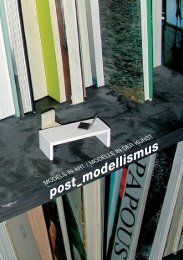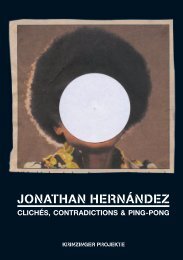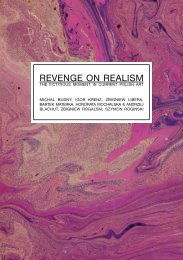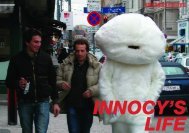Tirol Transfer - krinzinger projekte - Galerie Krinzinger
Tirol Transfer - krinzinger projekte - Galerie Krinzinger
Tirol Transfer - krinzinger projekte - Galerie Krinzinger
Create successful ePaper yourself
Turn your PDF publications into a flip-book with our unique Google optimized e-Paper software.
Portrait of a Clonal City - Shige (Disqualified)<br />
series by Goang-ming Yuan<br />
Ningen Shikkaku (translated as Human Disqualified*)<br />
did not fascinate Goang-ming<br />
Yuan. Reading the Chinese translation of<br />
Osamu Dazai“s Japanese novel, it was the<br />
title that compelled him. Ren Jian Shi Ge.<br />
For those who read and write Chinese, the<br />
literal meaning of the four characters is<br />
clear, but it is not easy to identify the „meaning“:<br />
maybe because of its indeterminacy,<br />
Yuan became fascinated with the unspeakable<br />
beauty that the phrase contains.<br />
Shi Ge (dropped frames: or Diao Ge) the<br />
Chinese term in digital image processing,<br />
the phenomenon of frames dropping because<br />
of technical problems, perhaps because<br />
of a delay in the PCs’ processing<br />
speed or something else. In Japanese,<br />
Komaochi.<br />
Yuan looked for, and found, an interface<br />
between Shi Ge and the process of making<br />
the series. The scenery looks so smooth<br />
that people, on first glance, would not<br />
notice the extraordinariness of the city’s<br />
appearance, with no car, no human. Or<br />
even after would they imagine there are<br />
hidden some seventy frames, copied and<br />
pasted from more than three hundred<br />
photographs the artist took over two<br />
months.<br />
Yuan refers to ‘reproduction’ over and over<br />
again. „But now it’s cloning, while for<br />
Benjamin it was copying.“<br />
Thus the city is the clonal city, reproduced<br />
by digital technique. This innocent city, like<br />
a cloned calf that we would never identify<br />
as such unless told, has been created<br />
through several, technical processes. Yet<br />
it’s almost impossible to read these processes<br />
from the appearance of the work.<br />
These photographs are clear of any trace<br />
of process, such as the strokes on paintings,<br />
that let us imagine the movements<br />
of a painter’s body, or the irregular surfaces<br />
and marks of sculptures, with which we<br />
know how sculptors moved the material.<br />
With everything living and moving cut from<br />
14









